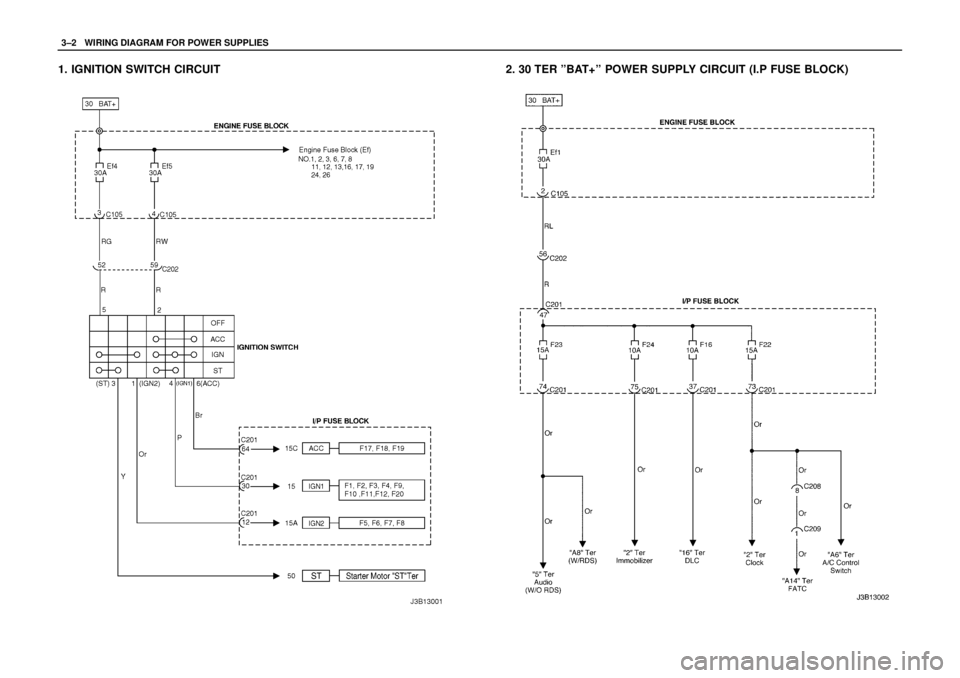2004 DAEWOO LACETTI ignition
[x] Cancel search: ignitionPage 875 of 2643

ENGINE CONTROLS 1F – 629
DAEWOO V–121 BL4
tentially interfere with the operation of the Exhaust Gas
Recirculation (EGR) valve and thereby turn on the MIL.
Small leaks in the exhaust system near the post catalyst
oxygen sensor can also cause the MIL to turn on.
Aftermarket electronics, such as cellular phones, stereos,
and anti–theft devices, may radiate electromagnetic inter-
ference (EMI) into the control system if they are improperly
installed. This may cause a false sensor reading and turn
on the MIL.
Environment
Temporary environmental conditions, such as localized
flooding, will have an effect on the vehicle ignition system.
If the ignition system is rain–soaked, it can temporarily
cause engine misfire and turn on the MIL.
Refueling
A new EOBD diagnostic checks the integrity of the entire
Evaporative (EVAP) Emission system. If the vehicle is re-
started after refueling and the fuel cap is not secured cor-
rectly, the on–board diagnostic system will sense this as
a system fault, turn on the MIL, and set DTC P0440.
Vehicle Marshaling
The transportation of new vehicles from the assembly
plant to the dealership can involve as many as 60 key
cycles within 2 to 3 miles of driving. This type of operation
contributes to the fuel fouling of the spark plugs and will
turn on the MIL with a set DTC P0300.
Poor Vehicle Maintenance
The sensitivity of EOBD diagnostics will cause the MIL to
turn on if the vehicle is not maintained properly. Restricted
air filters, fuel filters, and crankcase deposits due to lack
of oil changes or improper oil viscosity can trigger actual
vehicle faults that were not previously monitored prior to
EOBD. Poor vehicle maintenance can not be classified as
a ”non–vehicle fault,” but with the sensitivity of EOBD
diagnostics, vehicle maintenance schedules must be
more closely followed.
Severe Vibration
The Misfire diagnostic measures small changes in the
rotational speed of the crankshaft. Severe driveline vibra-
tions in the vehicle, such as caused by an excessive
amount of mud on the wheels, can have the same effect
on crankshaft speed as misfire and, therefore, may set
DTC P0300.
Related System Faults
Many of the EOBD system diagnostics will not run if the
engine controlmodule (ECM) detects a fault on a related
system or component. One example would be that if the
ECM detected a Misfire fault, the diagnostics on the cata-
lytic converter would be suspended until the Misfire fault
was repaired. If the Misfire fault is severe enough, the cat-
alytic converter can be damaged due to overheating andwill never set a Catalyst DTC until the Misfire fault is re-
paired and the Catalyst diagnostic is allowed to run to
completion. If this happens, the customer may have to
make two trips to the dealership in order to repair the ve-
hicle.
SERIAL DATA COMMUNICATIONS
Class II Serial Data Communications
Government regulations require that all vehicle manufac-
turers establish a common communication system. This
vehicle utilizes the ”Class II” communication system. Each
bit of information can have one of two lengths: long or
short. This allows vehicle wiring to be reduced by transmit-
ting and receiving multiple signals over a single wire. The
messages carried on Class II data streams are also priori-
tized. If two messages attempt to establish communica-
tions on the data line at the same time, only the message
with higher priority will continue. The device with the lower
priority message must wait. Themost significant result of
this regulation is that it provides scan tool manufacturers
with the capability to access data from any make or model
vehicle that is sold.
The data displayed on the other scan tool will appear the
same, with some exceptions. Some scan tools will only be
able to display certain vehicle parameters as values that
are a coded representation of the true or actual value. On
this vehicle the scan tool displays the actual values for ve-
hicle parameters. It will not be necessary to perform any
conversions from coded values to actual values.
ON–BOARD DIAGNOSTIC (EOBD)
On–Board Diagnostic Tests
A diagnostic test is a series of steps, the result of which is
a pass or fail reported to the diagnostic executive. When
a diagnostic test reports a pass result, the diagnostic
executive records the following data:
S The diagnostic test has been completed since the
last ignition cycle.
S The diagnostic test has passed during the current
ignition cycle.
S The fault identified by the diagnostic test is not cur-
rently active.
When a diagnostic test reports a fail result, the diagnostic
executive records the following data:
S The diagnostic test has been completed since the
last ignition cycle.
S The fault identified by the diagnostic test is current-
ly active.
S The fault has been active during this ignition cycle.
S The operating conditions at the time of the failure.
Remember, a fuel trim Diagnostic Trouble Code (DTC)
may be triggered by a list of vehicle faults. Make use of all
information available (other DTCs stored, rich or lean con-
dition, etc.) when diagnosing a fuel trim fault.
Page 878 of 2643

1F – 632IENGINE CONTROLS
DAEWOO V–121 BL4
READING DIAGNOSTIC TROUBLE
CODES
The procedure for reading diagnostic trouble code(s) is to
use a diagnostic scan tool. When reading Diagnostic
Trouble Codes (DTCs), follow the instructions supplied by
tool manufacturer.
DTC Modes
On On–Board Diagnostic (EOBD) passenger cars there
are five options available in the scan tool DTC mode to dis-
play the enhanced information available. A description of
the new modes, DTC Info and Specific DTC, follows. After
selecting DTC, the following menu appears:
S DTC Info.
S Specific DTC.
S Freeze Frame.
S Fail Records (not all applications).
S Clear Info.
The following is a brief description of each of the sub me-
nus in DTC Info and Specific DTC. The order in which they
appear here is alphabetical and not necessarily the way
they will appear on the scan tool.
DTC Information Mode
Use the DTC info mode to search for a specific type of
stored DTC information. There are seven choices. The
service manual may instruct the technician to test for
DTCs in a certain manner. Always follow published service
procedures.
To get a complete description of any status, press the ”En-
ter” key before pressing the desired F–key. For example,
pressing ”Enter” then an F–key will display a definition of
the abbreviated scan tool status.
DTC Status
This selection will display any DTCs that have not run dur-
ing the current ignition cycle or have reported a test failure
during this ignition up to a maximum of 33 DTCs. DTC
tests which run and pass will cause that DTC number to
be removed from the scan tool screen.
Fail This Ign. (Fail This Ignition)
This selection will display all DTCs that have failed during
the present ignition cycle.
History
This selection will display only DTCs that are stored in the
ECM’s history memory. It will not display type CNL DTCs
that have not requested the Malfunction Indicator Lamp
(MIL). It will display all type A, B and E DTCs that have re-
quested the MIL and have failed within the last 40 warm–
up cycles. In addition, it will display all type C and type D
DTCs that have failed within the last 40 warm–up cycles.
Last Test Fail
This selection will display only DTCs that failed the last
time the test ran. The last test may have run during a pre-
vious ignition cycle if a type A or type B DTC is displayed.
For type C and type D DTCs, the last failure must have oc-
curred during the current ignition cycle to appear as Last
Test Fail.
MIL Request
This selection will display only DTCs that are requesting
the MIL. Type C and type D DTCs cannot be displayed us-
ing this option. This selection will report type B DTCs only
after the MIL has been requested.
Not Run SCC (Not Run Since Code Clear)
This option will display up to 33 DTCs that have not run
since the DTCs were last cleared. Since any displayed
DTCs have not run, their condition (passing or failing) is
unknown.
Test Fail SCC (Test Failed Since Code
Clear)
This selection will display all active and history DTCs that
have reported a test failure since the last time DTCs were
cleared. DTCs that last failed more than 40 warm–up
cycles before this option is selected will not be displayed.
Specific DTC Mode
This mode is used to check the status of individual diag-
nostic tests by DTC number. This selection can be ac-
cessed if a DTC has passed, failed or both. Many EOBD
DTC mode descriptions are possible because of the ex-
tensive amount of information that the diagnostic execu-
tive monitors regarding each test. Some of the many pos-
sible descriptions follow with a brief explanation.
The ”F2” key is used, in this mode, to display a description
of the DTC. The ”Yes” and ”No” keys may also be used to
display more DTC status information. This selection will
only allow entry of DTC numbers that are supported by the
vehicle being tested. If an attempt is made to enter DTC
numbers for tests which the diagnostic executive does not
recognize, the requested information will not be displayed
correctly and the scan tool may display an error message.
The same applies to using the DTC trigger option in the
Snapshot mode. If an invalid DTC is entered, the scan tool
will not trigger.
Failed Last Test
This message display indicates that the last diagnostic
test failed for the selected DTC. For type A and type B
DTCs, this message will be displayed during subsequent
ignition cycles until the test passes or DTCs are cleared.
For type C and type D DTCs, this message will clear when
the ignition is cycled.
Failed Since Clear
This message display indicates that the DTC has failed at
least once within the last 40 warm–up cycles since the last
time DTCs were cleared.
Page 879 of 2643

ENGINE CONTROLS 1F – 633
DAEWOO V–121 BL4
Failed This Ig. (Failed This Ignition)
This message display indicates that the diagnostic test
has failed at least once during the current ignition cycle.
This message will clear when DTCs are cleared or the igni-
tion is cycled.
History
This message display indicates that the DTC has been
stored in memory as a valid fault. A DTC displayed as a
History fault may not mean that the fault is no longer pres-
ent. The history description means that all the conditions
necessary for reporting a fault have been met (maybe
even currently), and the information was stored in the con-
trol module memory.
MIL Requested
This message display indicates that the DTC is currently
causing the MIL to be turned ON. Remember that only
type A and type B DTCs can request the MIL. The MIL re-
quest cannot be used to determine if the DTC fault condi-
tions are currently being experienced. This is because the
diagnostic executive will require up to three trips during
which the diagnostic test passes to turn OFF the MIL.
Not Run Since CI (Not Run Since Cleared)
This message display indicates that the selected diagnos-
tic test has not run since the last time DTCs were cleared.
Therefore, the diagnostic test status (passing or failing) is
unknown. After DTCs are cleared, this message will con-
tinue to be displayed until the diagnostic test runs.
Not Run This Ig. (Not Run This Ignition)
This message display indicates that the selected diagnos-
tic test has not run during this ignition cycle.
Test Ran and Passed
This message display indicates that the selected diagnos-
tic test has done the following:
S Passed the last test.
S Run and passed during this ignition cycle.
S Run and passed since DTCs were last cleared.
If the indicated status of the vehicle is ”Test Ran and
Passed” after a repair verification, the vehicle is ready to
be released to the customer.
If the indicated status of the vehicle is ”Failed This Ignition”
after a repair verification, then the repair is incomplete and
further diagnosis is required.
Prior to repairing a vehicle, status information can be used
to evaluate the state of the diagnostic test, and to help
identify an intermittent problem. The technician can con-
clude that although the MIL is illuminated, the fault condi-
tion that caused the code to set is not present. An intermit-
tent condition must be the cause.
PRIMARY SYSTEM – BASED
DIAGNOSTICS
There are primary system–based diagnostics which eval-
uate system operation and its effect on vehicle emissions.
The primary system–based diagnostics are listed below
with a brief description of the diagnostic function:
Oxygen Sensor Diagnosis
The fuel control Front Heated Oxygen Sensor (HO2S1) is
diagnosed for the following conditions:
S Slow response.
S Response time (time to switch R/L or L/R).
S Inactive signal (output steady at bias voltage
approx. 450 mv).
S Signal fixed high.
S Signal fixed low.
The catalyst monitor Rear Heated Oxygen Sensor
(HO2S2) is diagnosed for the following conditions:
S Heater performance (time to activity on cold start).
S Signal fixed low during steady state conditions or
power enrichment (hard acceleration when a rich-
mixture should be indicated).
S Signal fixed high during steady state conditions or
deceleration mode (deceleration when a lean mix-
ture should be indicated).
S Inactive sensor (output steady at approximately 438
mv).
If the oxygen sensor pigtail wiring, connector or terminal
are damaged, the entire oxygen sensor assembly must be
replaced. Do not attempt to repair the wiring, connector or
terminals. In order for the sensor to function properly, it
must have clean reference air provided to it. This clean air
reference is obtained by way of the oxygen sensor wire(s).
Any attempt to repair the wires, connector or terminals
could result in the obstruction of the reference air and de-
grade oxygen sensor performance.
Misfire Monitor Diagnostic Operation
The misfire monitor diagnostic is based on crankshaft
rotational velocity (reference period) variations. The en-
gine control module (ECM) determines crankshaft rota-
tional velocity using the Crankshaft Position (CKP) sensor
and the Camshaft Position (CMP) sensor. When a cylinder
misfires, the crankshaft slows down momentarily. By mon-
itoring the CKP and CMP sensor signals, the ECM can cal-
culate when a misfire occurs.
For a non–catalyst damaging misfire, the diagnostic will be
required to monitor a misfire present for between
1000–3200 engine revolutions.
For catalyst–damaging misfire, the diagnostic will respond
to misfire within 200 engine revolutions.
Rough roads may cause false misfire detection. A rough
road will cause torque to be applied to the drive wheels and
drive train. This torque can intermittently decrease the
crankshaft rotational velocity. This may be falsely de-
tected as a misfire.
Page 918 of 2643

SECTION : 2C
FRONT SUSPENSION
CAUTION : Disconnect the negative battery cable before removing or installing any electrical unit or when a tool
or equipment could easily come in contact with exposed electrical terminals. Disconnecting this cable will help
prevent personal injury and damage to the vehicle. The ignition must also be in LOCK unless otherwise noted.
TABLE OF CONTENTS
SPECIFICATIONS2C–2 . . . . . . . . . . . . . . . . . . . . . . . . . .
General Specifications 2C–2. . . . . . . . . . . . . . . . . . . . .
Fastener Tightening Specifications 2C–2. . . . . . . . . . .
SPECIAL TOOLS2C–3 . . . . . . . . . . . . . . . . . . . . . . . . . . .
Special Tools Table 2C–3. . . . . . . . . . . . . . . . . . . . . . . .
DIAGNOSIS2C–5 . . . . . . . . . . . . . . . . . . . . . . . . . . . . . . . .
Strut Dampener 2C–5. . . . . . . . . . . . . . . . . . . . . . . . . . .
Ball Joint and Knuckle 2C–6. . . . . . . . . . . . . . . . . . . . . .
Excessive Friction Check 2C–6. . . . . . . . . . . . . . . . . . .
COMPONENT LOCATOR2C–7 . . . . . . . . . . . . . . . . . . . .
Front Suspension 2C–7. . . . . . . . . . . . . . . . . . . . . . . . . .
MAINTENANCE AND REPAIR2C–9 . . . . . . . . . . . . . . .
ON–VEHICLE SERVICE 2C–9. . . . . . . . . . . . . . . . . . . . .
Stabilizer Shaft and Insulators 2C–9. . . . . . . . . . . . . . . Stabilizer Link 2C–10. . . . . . . . . . . . . . . . . . . . . . . . . . . .
Knuckle Assembly 2C–10. . . . . . . . . . . . . . . . . . . . . . . .
Hub and Bearing 2C–13. . . . . . . . . . . . . . . . . . . . . . . . .
Control Arm 2C–14. . . . . . . . . . . . . . . . . . . . . . . . . . . . . .
Strut Assembly 2C–16. . . . . . . . . . . . . . . . . . . . . . . . . . .
Crossmember Assembly 2C–18. . . . . . . . . . . . . . . . . . .
UNIT REPAIR 2C–21. . . . . . . . . . . . . . . . . . . . . . . . . . . . .
Ball Joint 2C–21. . . . . . . . . . . . . . . . . . . . . . . . . . . . . . . .
Control Arm Bushings 2C–21. . . . . . . . . . . . . . . . . . . . .
Front Strut Assembly 2C–22. . . . . . . . . . . . . . . . . . . . . .
Knuckle 2C–23. . . . . . . . . . . . . . . . . . . . . . . . . . . . . . . . .
GENERAL DESCRIPTION AND SYSTEM
OPERATION 2C–25 . . . . . . . . . . . . . . . . . . . . . . . . . . . .
Front Suspension 2C–25. . . . . . . . . . . . . . . . . . . . . . . . .
Page 943 of 2643

SECTION : 2D
REAR SUSPENSION
CAUTION : Disconnect the negative battery cable before removing or installing any electrical unit or when a tool
or equipment could easily come in contact with exposed electrical terminals. Disconnecting this cable will help
prevent personal injury and damage to the vehicle. The ignition must also be in LOCK unless otherwise noted.
TABLE OF CONTENTS
SPECIFICATIONS2D–2 . . . . . . . . . . . . . . . . . . . . . . . . . .
Fastener Tightening Specifications 2D–2. . . . . . . . . . .
SPECIAL TOOLS2D–2 . . . . . . . . . . . . . . . . . . . . . . . . . . .
Special Tools Table 2D–2. . . . . . . . . . . . . . . . . . . . . . . .
DIAGNOSIS2D–3 . . . . . . . . . . . . . . . . . . . . . . . . . . . . . . . .
Excessive Friction Check 2D–3. . . . . . . . . . . . . . . . . . .
Strut Dampener 2D–3. . . . . . . . . . . . . . . . . . . . . . . . . . .
COMPONENT LOCATOR2D–4 . . . . . . . . . . . . . . . . . . . .
Rear Suspension 2D–4. . . . . . . . . . . . . . . . . . . . . . . . . .
MAINTENANCE AND REPAIR2D–6 . . . . . . . . . . . . . . .
ON–VEHICLE SERVICE 2D–6. . . . . . . . . . . . . . . . . . . . .
Strut Assembly 2D–6. . . . . . . . . . . . . . . . . . . . . . . . . . . .
Knuckle Assembly 2D–9. . . . . . . . . . . . . . . . . . . . . . . . .
Trailing Link 2D–10. . . . . . . . . . . . . . . . . . . . . . . . . . . . . . Trailing Link Bracket 2D–11. . . . . . . . . . . . . . . . . . . . . .
Front Parallel Link 2D–12. . . . . . . . . . . . . . . . . . . . . . . .
Rear Parallel Link 2D–13. . . . . . . . . . . . . . . . . . . . . . . . .
Stabilizer Shaft 2D–13. . . . . . . . . . . . . . . . . . . . . . . . . . .
Stabilizer Link 2D–14. . . . . . . . . . . . . . . . . . . . . . . . . . . .
Crossmember 2D–14. . . . . . . . . . . . . . . . . . . . . . . . . . . .
Hub and Bearing Assembly 2D–15. . . . . . . . . . . . . . . .
UNIT REPAIR 2D–17. . . . . . . . . . . . . . . . . . . . . . . . . . . . .
Springs and Insulators 2D–17. . . . . . . . . . . . . . . . . . . . .
Knuckle 2D–18. . . . . . . . . . . . . . . . . . . . . . . . . . . . . . . . .
Hub and Bearing 2D–19. . . . . . . . . . . . . . . . . . . . . . . . .
GENERAL DESCRIPTION AND SYSTEM
OPERATION 2D–20 . . . . . . . . . . . . . . . . . . . . . . . . . . . .
Rear Suspension 2D–20. . . . . . . . . . . . . . . . . . . . . . . . .
Page 974 of 2643

SECTION 3
WIRING DIAGRAM FOR POWER SUPPLIES
CONTENTS
1. IGNITION SWITCH CIRCUIT3–2 . . . . . . . . . . . . . . . . . . . . . . . . . . . . . . . . . . . . . . . . . . . . . . . . . . . . . . . . . . . . . . . . . . . . . .
2. 30 TER ”BAT+” POWER SUPPLY CIRCUIT(I.P FUSE BLOCK) 3–2. . . . . . . . . . . . . . . . . . . . . . . . . . . . . . . . . . . . . . .
3. 15 TER ”IGN 1” POWER SUPPLY CIRCUIT(I.P FUSE BLOCK) 3–3. . . . . . . . . . . . . . . . . . . . . . . . . . . . . . . . . . . . . . .
4. 15A TER ”IGN2”, 15C TER ”ACC” POWER SUPPLY CIRCUIT(I.P FUSE BLOCK) 3–4. . . . . . . . . . . . . . . . . . . . . .
5. ENGINE FUSE BLOCK & RELAY CIRCUIT 3–5. . . . . . . . . . . . . . . . . . . . . . . . . . . . . . . . . . . . . . . . . . . . . . . . . . . . . . . . .
Page 975 of 2643

3–2WWIRING DIAGRAM FOR POWER SUPPLIES
1. IGNITION SWITCH CIRCUIT2. 30 TER ”BAT+” POWER SUPPLY CIRCUIT (I.P FUSE BLOCK)
Page 1014 of 2643

4–2WUSAGE AND CAPACITY OF FUSES IN FUSE BLOCK
1. ENGINE ROOM RELAY AND FUSE BLOCK
1) POSITION OF RELAY AND FUSE
2) USAGE OF FUSE IN ENGINE FUSE BLOCK
Power
Supply
ClassificationFuse
NoCapacityUsage
Ef130ABattery Main(F13~F16, F21~F24)
Ef260AEBCM, Oil Feeding Conenctor
Ef330ABlower Relay
30SBEf430AIgnition Switch–2
BAT (+)(Slow–BlownEf530AIgnition Switch–1
Fuse)Ef620ACooling Fan Low Relay
Ef730ADefog Relay
Ef830ACooling Fan HI Relay
IGN2 (15A)Ef920APower Window Switch
IGN1 (15)Ef1015AFuel Connector, ECM (MR–140), LEGR, EI
System
30Ef1110AECM, Main Relay (Sirius D4)
BAT(+)Ef1225AHead lamp Relay, ILLUM. Relay
Ef1315ABrake Switch
IGN2 (15A)Ef1420APower Window Switch
56 LIGHTEf1515AHead Lamp HI
30Ef1615AHorn Relay, siren, Hood Contact Switch
BAT(+)Ef1710AA/C Comp. Relay
IGN1 (15)Ef1815AFuel Pump
30 BAT(+)Ef1915ACluster, Key Remind S/W, Folding Mirror Unit, MAP
Lamp, Room Lamp, Trunk Open lamp, Trunk
Open S/W
56 LIGHTBlade TypeEf2010AHead Lamp Low
IGN1 (15)/FuseEf2115AEVAP Canister Purge Solenoid, HO2S, Cooling
Fan Relay
30 BAT(+)Ef2215Ainjector, EGR, EEGR
ILLUM. (58)Ef2310ALicense Plate Lamp, Chime Bell, Tail Lamp, Head
Lamp
30 BAT (+)Ef2415AFog Lamp Relay
IGN2 (15A)Ef2510AElectric OSRV Mirror
30 BAT (+)Ef2615ACentral Door Lock Unit
56 LIGHTEf2710AHead Lamp Low
ILLUM. (58)Ef2810AILLUM. Circuit, Head Lamp, Tail Lamp
SPAREEf2910ANot Used
Ef3015ANot Used
Ef3125ANot Used